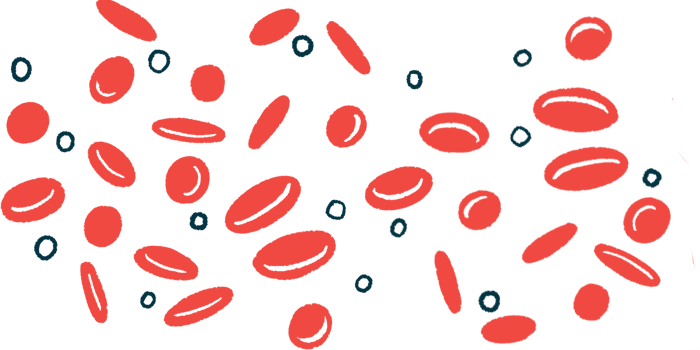Higher FTX-6058 Doses Raise Hemoglobin in Healthy Adults in Trial

Higher doses of FTX-6058, an investigational oral treatment for sickle cell disease (SCD), effectively raised hemoglobin messenger RNA (mRNA) levels above those found at lower doses in healthy volunteers participating in a Phase 1 trial, new data suggests.
Increases in hemoglobin mRNA — the molecule cells use as a template to produce proteins — translated to similar increases in the number of red blood cells containing fetal hemoglobin, a form of hemoglobin produced during fetal development that is more effective at transporting oxygen than its adult counterpart.
Fulcrum Therapeutics, the therapy’s developer, also reported preclinical data showing that FTX-6058 lowered the production of two known fetal hemoglobin protein repressors.
Based on these interim findings, the company hopes to launch a Phase 1b trial of FTX-6058 in people with SCD, with enrollment expected to begin later this year.
“The data for FTX-6058 continue to exceed our expectations,” Bryan Stuart, Fulcrum’s president and CEO, said in a press release. “We believe the fold increases in [hemoglobin] mRNA that we have now seen at multiple doses, starting at 6mg once-daily, have the potential to translate to levels of [fetal hemoglobin] protein that could provide a functional cure for people with sickle cell disease.
“Additionally, with the new insights into the mechanism of action, there’s now a clear relationship between FTX-6058 and [fetal hemoglobin] induction that further affirms our conviction,” Stuart added. “We remain on track to begin enrolling people with sickle cell disease in our Phase 1b trial by year-end, with an eye toward reporting initial data, including [fetal hemoglobin] protein levels, in the second quarter of next year.”
SCD is caused by mutations in the gene the encodes hemoglobin — the protein that carries oxygen in red blood cells. Current therapies are limited in efficacy, and new experimental gene therapies are only available to certain patients. FTX-6058 is designed to boost the production of fetal hemoglobin, improve oxygen transport, and alleviate disease symptoms.
“Despite progress in the treatment of sickle cell disease, existing therapies either offer limited benefit or, in the case of gene therapy, are not amenable to the great majority of patients and carry certain risks,” said Gerd Blobel, MD, PhD, at Children’s Hospital of Philadelphia. “The strategy of increasing the levels of fetal hemoglobin is based on solid genetic and clinical data. It can substantially reduce mortality and morbidity, and in cases where HbF reaches greater than 25–35% of total hemoglobin, lead to asymptomatic disease.”
The safety and tolerability of single- and multiple-ascending doses of FTX-6058 are currently being investigated in a placebo-controlled Phase 1 trial (NCT04586985) enrolling healthy adult volunteers.
The trial is also investigating how the medicine moves into, through, and out of the body (pharmacokinetics), as well as target engagement, changes in hemoglobin mRNA levels, and its impact on the number of immature red blood cells containing fetal hemoglobin (F-reticulocytes).
Some participants were randomly assigned to receive single ascending doses of FTX-6058, ranging from 2 milligrams (mg) to 60 mg to date, or a placebo, while others received multiple ascending doses of the investigational therapy, starting at 2 mg and rising up to 30 mg, or a placebo, both given once daily for 14 days.
Previous interim results showed that multiple ascending doses led to proportional increases in fetal hemoglobin, both at the mRNA and protein levels, and increased the number of F-reticulocytes. After 14 days, the 6 mg dose increased mRNA levels by more than threefold and the 10 mg dose by more than fourfold.
New trial data from the 20 mg dose groups showed that by day 14, hemoglobin mRNA levels had risen by a mean of 5.6 times. Among participants in the 30 mg dose groups, hemoglobin mRNA levels rose by a mean of 6.2 times.
“These increases were even higher than those observed at the 2, 6 and 10mg doses announced in August 2021. Extensive evidence from studies in human genetics shows that even a 2–3 fold increase in [fetal hemoglobin] is shown to have a positive benefit for people living with SCD, including reduced mortality and fewer pain-crisis events, and even resulting in a functional cure,” Stuart said in an emailed statement to Sickle Cell Disease News.
F-reticulocytes also increased by a mean of 1.8 times in the 20 mg group and a mean of 2.4 times in the 30 mg group, seven to 10 days after dosing. According to Fulcrum, higher numbers of F-reticulocytes are the first indicator that increases in hemoglobin mRNA levels are translating to enhanced fetal hemoglobin production.
Supporting a once-daily dosing regimen, trial data continued to suggest dose-dependent pharmacokinetics in multiple ascending dose groups, with a six- to seven-hour half-life — the time it takes for FTX-6058 to drop to half in the body. The intake of food did not affect these results.
In addition, multiple ascending dose data continued to show strong target engagement, as measured by a 75–95% drop in H3K27me3, a protein that silences hemoglobin gene activity.
Fulcrum also reported new preclinical data demonstrating that FTX-6058 potently suppressed the expression, or production, of BCL11A and MYB — known repressors of fetal hemoglobin — both in cellular and animal models. This suggests the therapy may enhance fetal hemoglobin production by silencing two of its known repressors.
“The emerging clinical data on FTX-6058, combined with the new preclinical data showing that it downregulates BCL11A and MYB, two validated HbF repressors, is encouraging,” Blobel added.
In line with earlier safety data, FTX-6058 was generally well-tolerated with no serious adverse events reported and no discontinuations due to treatment-emergent adverse events (TEAEs). All TEAEs possibly related to FTX-6058 were mild and resolved in all participants. Two more serious events were reported, but both were determined to be unrelated to FTX-6058.
“These results support the potential for FTX-6058 to provide significant benefit for patients, with an advantageous safety profile and the convenience of oral administration. We are advancing this program in a Phase 1b trial in people with SCD,” Stuart said.
The Phase 1b trial, set to begin by the end of the year, is a proof of concept study to evaluate FTX-6058 in people with SCD. The open-label trial will assess the effects of FTX-6058 on fetal hemoglobin induction, as well as its safety, tolerability, pharmacokinetics, and pharmacodynamics — the therapy’s impact on the body and its mechanism of action.
Groups of up to 10 patients will receive up to three doses, starting at 6 mg once daily, to inform dose selection for future studies. Fulcrum expects to have initial data in the second quarter of 2022 and plans to launch a pivotal Phase 2/3 trial in 2023.
The company is also planning to submit a request to U.S. regulatory authorities by the end of the year to start testing FTX-6058 in patients with other hemoglobin-related diseases, including beta-thalassemia.








